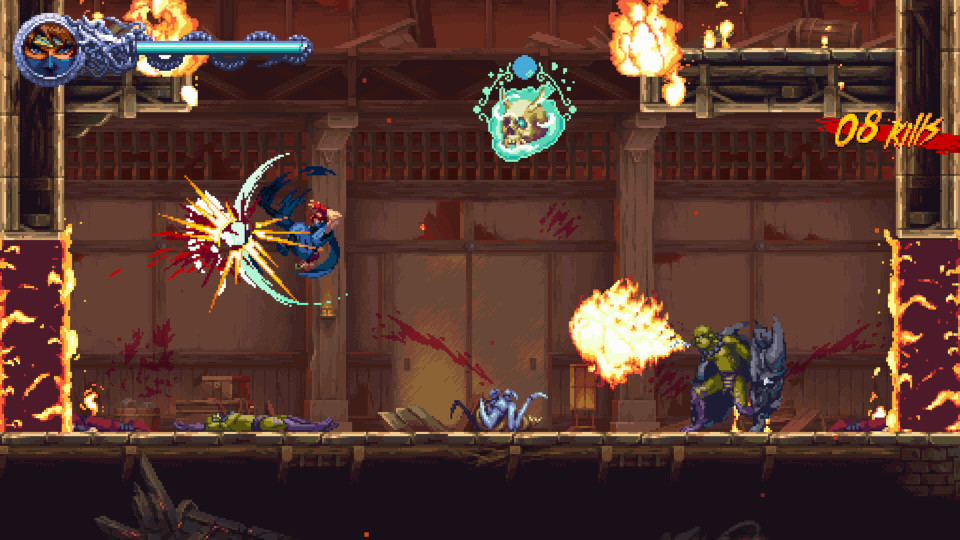While most gamers will recognise Ninja Gaiden through its full 3D entries from the original Xbox and beyond the series actually began way back in 1988 on the NES (and arcade). The first games were released in Europe as Shadow Warriors with the iconic name being used worldwide with the turn to 3D. While these earlier games are a very different beast to the modern ones they do share one key characteristic – they are hard as nails. Before Dark Souls became the shorthand for difficult games it was Ninja Gaiden that held the sadistic crown. Ragebound can continue this trend if you want it to but also contains a more streamlined difficulty setting that is perfect for learning the game.
Ragebound is developed by The Game Kitchen, most famous for their fantastic Blasphemous titles. These games had a similar hardcore approach but functioned more as search adventures than straight-forward action platformers. When the developers were announced, there was some speculation that Ninja Gaiden might be taking the turn towards backtracking and levelling up but I can happily report that the new game feels as close to a modern take on the originals as you can get. I tested this by playing through the original on Switch Online but haven’t finished it yet – did I mention that it was hard?
The modern graphics have a great sense of style while still being in keeping with the original. The sprites resemble a modern update of the best of 16-bit aesthetics, featuring colourful environments and hordes of demons to fight. Special mention needs to be made for the soundtrack too, which has some of the best rocking game music you’ll hear. I can’t wait to check out the full track list when it releases and anticipate it making an appearance on my shuffle play for quite a while to come.
Chronologically, Ragebound fits in alongside the first Ninja Gaiden game, in which long-running protagonist Ryu Hayabusa travels to America to honour his father’s will. This is shown through an introductory cutscene that serves to establish new hero Kenji Mozu whilst also setting up a nice tongue-in-cheek counter to initial complaints about the change in character. Functionally, Kenji is similar to Ryu but with a shock of ginger hair to give much-needed representation to us carrot tops (technically it’s only my beard that’s ginger, but that still counts!).

Unlike the more realistic urban 1980s environment of much of the original game, Ragebound starts off in a timeless Japanese village being attacked by demons. The supernatural enemy here allows for a lot more range in foes than the thugs and ninjas and some are suitably grotesque and challenging. Alongside your standard sword attack, some enemies will provide a necessary supercharge to your weapon, which is needed to quickly defeat shielded enemies and barriers, offering a nice element of strategy. Secondary throwable weapons are also available when you have enough ninja charge which are useful for picking off tricky enemies or inflicting quick damage on bosses. Most interesting of all is the ability to bounce on enemies and projectiles which feels very in keeping with the Blasphemous titles but utilised in a more traditional platforming game.
The demo I played included the first level and also a couple of later ones showing an extra gameplay mechanic in which Kenji seems to have been fused with another mysterious character whom he can call on to explore a shadowy alternative world that interacts with the main one. This adds an environmental puzzle aspect to these levels that is really interesting, although I do question how much it’ll break the flow of the action.
Once the demo levels are beaten a hard mode is unlocked that plays a lot more like the original in terms of enemy challenge and infrequent checkpoints. This promises to be a suitable challenge for those looking for that, and I’m intrigued to see whether this stays as an unlockable or if it’ll be open to choose as a first play experience.
Suffice it to say that Ninja Gaiden: Ragebound is an absolute blast and really manages to combine the past and present to produce a game that looks and controls brilliantly. The added hard mode continues the legacy of the series, whilst the standard one feels more accessible to newcomers (or oldies like me whose reactions aren’t what they used to be). When the full game comes out, it promises to be a real standard bearer for traditional 2d arcade platformers, and I am champing at the bit to get my hands on it.
